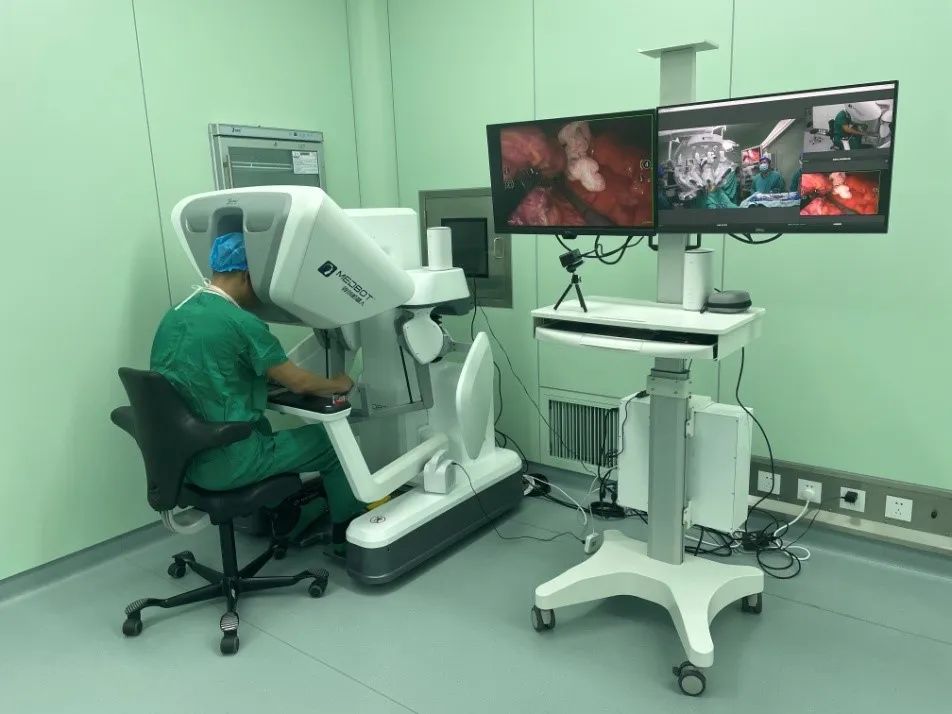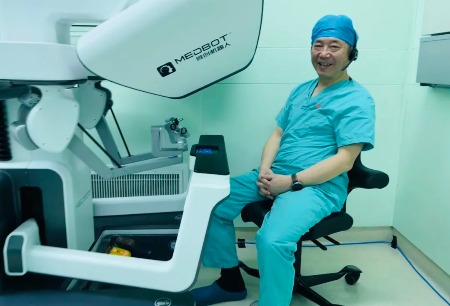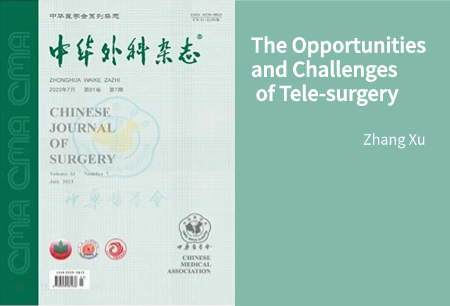China, Gansu - Recently, under the guidance of Director Suhe and Director Mayuntao from the Department of General Surgery at Gansu Provincial People's Hospital, Dr. Wang Xiaopeng, Chief Physician of the Department of General Surgery, led the weight loss and metabolic surgery team to successfully complete the world's first 5G remote robot-assisted sleeve gastrectomy using the Toumai® Surgical Robot (referred to as Toumai®). This surgical procedure is currently one of the most widely used weight loss and metabolic surgeries. It represents a significant breakthrough in the concepts and techniques of weight loss and metabolic surgery, marking Gansu Provincial People's Hospital's leading position in the exploration of 5G tele-surgery and the enhancement of surgical capabilities in the field of general surgery, not only in China but also globally.
Once again, a global milestone has been achieved, further demonstrating that Toumai®, with its advantages of precise identification, precise dissection, and meticulous resection, along with advanced 5G remote technology, can assist multidisciplinary medical teams in providing a wider range of indications and more effective treatment options for minimally invasive surgeries.

▲Toumai® assisted the world's first 5G remote sleeve gastrectomy
It is reported that weight loss and metabolic surgery includes more than ten treatment methods, with sleeve gastrectomy being the most widely used procedure. This surgery not only helps achieve weight reduction but also improves metabolic conditions, particularly for treating diabetes. Hence, it is referred to as weight loss and metabolic surgery.
According to the "Chinese Guidelines for Surgical Treatment of Obesity and Type 2 Diabetes (2019 edition)," sleeve gastrectomy has two main indications. Firstly, when BMI exceeds 32.5, surgery is recommended. Secondly, if the BMI falls between 27.5 and 32.5, at least two metabolic syndromes should be present, such as hypertension, type 2 diabetes, endocrine disorders, hyperuricemia, male sexual dysfunction, polycystic ovary syndrome, or renal function abnormalities. Additionally, lifestyle changes and internal medicine treatments should have been tried but failed to achieve control before considering surgery.
The patient undergoing the surgery is a female with a weight of up to 180 pounds, a BMI of 34.7 kg/m², and a waist circumference of 100 cm. She also has comorbidities such as metabolic syndrome, type 2 diabetes, moderate fatty liver, hyperlipidemia, severe obstructive sleep apnea with hypoventilation syndrome, and menstrual disorders. Her physical condition raises frequent red flags. When the patient and her family learned about the possibility of weight reduction through robot-assisted minimally invasive gastrointestinal surgery, they eagerly came to Gansu Provincial People's Hospital.
Following admission, Director Suhe and Director Mayuntao led the preoperative discussions, meticulously outlining the surgical plan and implementing a comprehensive 5G remote control surgical contingency plan. The anesthesia and surgical team, along with the 5G remote control technology support team, closely collaborated. Building on the early experience with Chinese developed Toumai®, the setup was based on a dual-console remote robotic system, ensuring the utmost safety throughout the patient's surgical procedure.
The two directors explained that weight loss and metabolic surgery have shown rapid effectiveness and long-lasting effects in weight reduction and glycemic control, bringing hope to a large number of patients with obesity and type 2 diabetes. However, not all obese and diabetic patients are suitable for surgery. A comprehensive treatment approach is required, involving a multidisciplinary team of professionals for evaluation. Sleeve gastrectomy is performed using minimally invasive laparoscopic techniques, removing the greater curvature and fundus of the stomach while leaving behind a sleeve-like structure on the lesser curvature. After the surgery, patients experience reduced food intake, and the associated metabolic hormones undergo changes, resulting in a reshaping of their physique.
On the day of the surgery, effective communication was maintained between the surgical consoles, with a stable network signal and synchronous transmission of surgical images. Director Wang Xiaopeng and his weight loss and metabolic surgery team cooperated closely, utilizing the most advanced techniques to minimize trauma, reduce bleeding, and successfully complete the surgery with high quality. The surgical team expressed that compared to laparoscopic weight loss surgery, the Toumai® robot-assisted weight loss and metabolic surgery utilizes naked-eye three-dimensional imaging, overcoming the lack of depth perception in traditional 2D laparoscopy. It alleviates visual fatigue and dizziness caused by prolonged use of 3D glasses in 3D laparoscopy and provides a 10-fold magnification of the surgical field, significantly enhancing the recognition of anatomical structures for more precise surgical operations. The wrist articulating instruments can rotate 540 degrees, surpassing the limitations of human hands, allowing for stable and accurate maneuvering in the complex and narrow anatomical areas associated with obesity. This ensures the safety of patients during surgery and promotes early recovery.
Director Mayuntao stated that 5G tele-surgery has broken the geographic limitations of medical technology and transformed the diagnostic and treatment models for doctors. It enables the sharing of high-quality resources and truly puts patient-centered medical services into practice, benefiting the general population to a greater extent and meeting various health needs at the grassroots level. It also promotes the development of the industry and contributes to the construction of a healthy China.
According to the hospital, since the first weight loss and metabolic surgery was performed in 2018, the Department of Weight Loss and Metabolic Surgery at Gansu Provincial People's Hospital has made significant progress and maturity. They have successfully helped over a hundred obese patients achieve weight loss. Currently, they are the institution with the highest number of weight loss surgeries, the most standardized procedures, the most comprehensive treatments, and the greatest impact in Gansu Province. The multidisciplinary team (MDT) approach, consisting of the General Surgery Clinical Center, Endocrinology Department, Cardiology Department, Sleep Center, Obstetrics and Gynecology Department, Gastroenterology Department, Nutrition Department, Anesthesia and Surgical Department, and other relevant departments, will provide comprehensive, personalized, and systematic standardized diagnosis and treatment for obese patients. This approach ensures the safety of weight loss surgery and the perioperative period for obese patients.
Liu Yu, Executive Vice President and Chief Commercial Officer of MicroPort® MedBot®, stated,
Since May of this year, under the leadership of President Cai Hui, Gansu Provincial People's Hospital has successfully completed over 30 exploratory 5G remote surgeries, continuously setting records as the first in the western region, the first in the country, and even the first in the world. The surgical complexity has gradually increased, and the level of technology has continued to improve, placing us at the forefront in the western region, across the country, and globally. This initiative has allowed high-quality medical resources to reach and benefit the general population of Gansu Province. Furthermore, Gansu Provincial People's Hospital has played a significant role in radiation and leadership. Through activities such as lectures by renowned experts, surgical demonstrations, personnel training, and 5G remote animal surgery shows, the cutting-edge robot technology and surgical skills are brought to hospitals and units in counties within the province. This has advanced the surgical techniques and academic development in the entire province and even the northwest region, embodying the principle of "Make surgery easier, safer and less invasive."







 " are registered trademarks of Shanghai MicroPort Medical (Group) Co., Ltd.” . They have been authorized to be used by Shanghai Microport Medbot (Group) Co., Ltd., and no other party shall use such trademarks without prior written permission thereof.
" are registered trademarks of Shanghai MicroPort Medical (Group) Co., Ltd.” . They have been authorized to be used by Shanghai Microport Medbot (Group) Co., Ltd., and no other party shall use such trademarks without prior written permission thereof.
